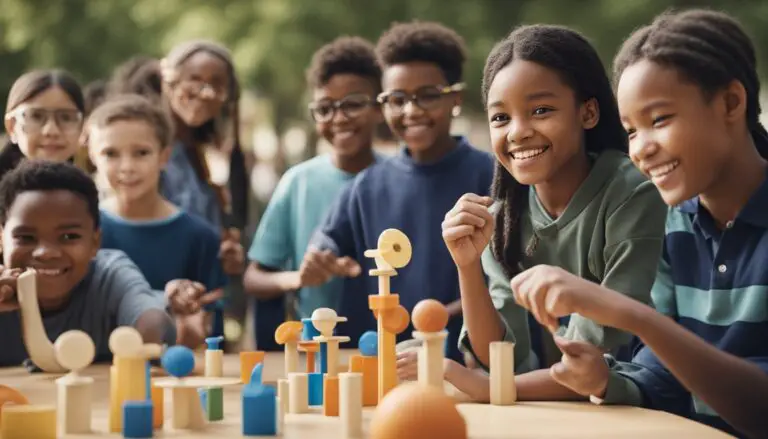School Vocabulary Exercises can revolutionize how students interact with language, and I’m thrilled to present the most efficient and delightful techniques I’ve gathered to enhance their voyage in vocabulary.
The Power of Vocabulary Games

From my first-hand experience, I’ve seen that vocabulary activities for school can ignite a thrill like no other, transforming even the driest lesson into a hotbed of excitement. Now, let’s dive into the dynamics of how these games can supercharge students’ engagement.
Boosting Engagement Through Words
Understanding through play: Isn’t it incredible when learning doesn’t feel like work? Vocabulary games do just that; by incorporating role-plays or word-based board games, students often forget they’re actively expanding their language arsenal. They’re more attentive, they participate with zest, and before they know it, they’re wordslingers with boosted vocabularies.
The Role of Competition in Learning
A healthy dose of competition: When I pit my students against each other in a friendly match of ‘Word Wizards,’ the energy skyrockets! Here’s the deal, when learners strive to outdo their peers in a vocabulary quiz or a crossword duel, not only are they learning, they’re also developing critical thinking and problem-solving skills amidst the fun. The right level of competition can lead to a deepened understanding and retention of new words.
Interactive Games and Competitions

Enhance learning with Interactive Games and Competitions, effective vocabulary activities for school that engage students in dynamic and enjoyable ways. Organize spelling bees, word association games, or vocabulary Jeopardy to promote healthy competition and encourage students to apply their vocabulary knowledge actively and creatively.
1. Vocabulary Bingo: Interactive Learning with Fun
- Fun-Factor: 😄😄😄😄
- Cost-Factor: 💸
- Difficulty: 💪
Vocabulary Bingo is a fun and interactive way to learn new words. First, create bingo cards where each square contains a vocabulary word instead of the traditional number. During gameplay, read out definitions, synonyms, or use the words in sentences as clues. Students then have to identify the word on their cards and mark it. This game not only makes learning vocabulary exciting but also reinforces word meanings and associations through repeated exposure.
2. Word Relay Races: Active Learning with Teamwork
- Fun-Factor: 😄😄😄😄😄
- Cost-Factor: 💸
- Difficulty: 💪💪
Turn vocabulary review into a sport with Word Relay Races! Divide your students into teams, and have them take turns running to the board to write a correct synonym or antonym for a word you show. This fast-paced game encourages students to think quickly and offers a physical outlet, making learning more dynamic. It’s an excellent way for students to engage with words and their meanings, fostering a spirit of competition and cooperation.
3. Scrabble Tournament: Strategic Vocabulary Enhancement
- Fun-Factor: 😄😄😄😄
- Cost-Factor: 💸💸
- Difficulty: 💪💪💪
Organize a Scrabble tournament where the focus is on using new vocabulary words. This activity challenges students to think strategically about word placement and word choice, enhancing both their vocabulary and critical thinking skills. Scrabble also allows students to see the words in a different context, involving them in deeper learning through the construction of words from individual letters.
4. Crossword Puzzles: Customized Learning Tool
- Fun-Factor: 😄😄😄
- Cost-Factor: 💸
- Difficulty: 💪💪💪
Create custom crossword puzzles that incorporate the vocabulary words your students are learning. This task not only aids in reinforcing word meanings and spellings but also enhances problem-solving skills as students work to figure out where words fit based on the given clues. Crosswords can be tailored to any vocabulary list, making it a versatile activity suitable for any level of learner.
5. Jeopardy-Style Review Game: Engaging Review Sessions
- Fun-Factor: 😄😄😄😄
- Cost-Factor: 💸💸
- Difficulty: 💪💪💪
Set up a classroom Jeopardy-style review game with categories that relate to the vocabulary, such as “Synonyms,” “Antonyms,” “In a Sentence,” and “Word Roots.” This type of game turns review sessions into a dynamic and competitive learning experience. Students can work in teams to answer questions, which helps reinforce their understanding of vocabulary while encouraging teamwork and strategic thinking.
6. Word Sorting: Organize Words to Understand Better
- Fun-Factor: 😄😄😄
- Cost-Factor: 💸
- Difficulty: 💪💪
Have your students engage in a Word Sorting activity, where they must categorize words based on parts of speech, prefixes, suffixes, or word roots. This exercise helps them to understand the structure and function of words, enhancing their language skills and preparing them for more advanced language use. It’s a hands-on way to explore the relationships between words and their components, making the learning process more analytical and comprehensive.
Creative Writing and Expression

Foster imagination and articulate expression through Creative Writing and Expression, essential vocabulary activities for school. Encourage students to use new words in poetry, short stories, or journal entries. This activity not only expands their vocabulary but also helps in understanding the nuances of language and expressing thoughts more effectively.
7. Story Starters: Spark Creativity with Vocabulary
- Fun-Factor: 😄😄😄😄
- Cost-Factor: 💸
- Difficulty: 💪💪
Story starters are an excellent way to get your students’ creative juices flowing while incorporating new vocabulary. Provide prompts or the beginnings of stories that must include specific vocabulary words in their continuation. This activity not only aids in learning new words but also enhances writing skills by challenging students to use these words in a narrative context. Encourage them to be as imaginative as possible, which can make learning vocabulary fun and memorable.
8. Poetry Writing: Expressive Learning with Vocabulary Words
- Fun-Factor: 😄😄😄
- Cost-Factor: 💸
- Difficulty: 💪💪💪
Challenge your students to express themselves through poetry by using a list of vocabulary words. This activity helps students learn and understand words deeply as they think about how to fit them into poetic lines and structures. It’s a creative and engaging way to explore the nuances of language and expression. Plus, sharing their poems in class can boost confidence and improve public speaking skills.
9. Word of the Day Journal: Daily Dives into Vocabulary
- Fun-Factor: 😄😄😄
- Cost-Factor: 💸
- Difficulty: 💪
Encourage your students to keep a “Word of the Day” journal, where they can explore a new word each day. They should write down the definition, synonyms, and an original sentence using the word. This daily practice not only builds writing skills but also helps students develop a habit of learning and reflecting on new vocabulary regularly. It’s a personal and reflective way to grow their vocabulary over time.
10. Comic Strip Creations: Visual Storytelling with Words
- Fun-Factor: 😄😄😄😄
- Cost-Factor: 💸💸
- Difficulty: 💪💪💪
Have your students create comic strips that incorporate vocabulary words in the dialogue. This visually engaging activity combines artistic expression with vocabulary learning, making it a fun project for students who might prefer drawing to writing. It helps them think about how words can be used in dialogue and offers a unique perspective on language usage within a narrative context.
11. Blog Posts: Engage with Vocabulary in Real-World Contexts
- Fun-Factor: 😄😄😄
- Cost-Factor: 💸💸
- Difficulty: 💪💪💪
Assign your students to write blog posts where they must use specific vocabulary words to discuss topics they’re passionate about. This activity not only ensures that they learn how to use new vocabulary correctly but also allows them to connect these words with their interests and experiences, making the learning process more relevant and enjoyable. It’s a great way for them to practice their writing skills and express their opinions.
12. Vocabulary Videos: Interactive and Multimedia Learning
- Fun-Factor: 😄😄😄😄
- Cost-Factor: 💸💸💸
- Difficulty: 💪💪💪
Let your students get creative by making short videos where they explain the meaning and usage of vocabulary words. They can create skits, use animations, or simply explain the words in a vlog-style format. This multimedia approach caters to different learning styles and can be particularly effective for visual and auditory learners. It also provides a modern twist to vocabulary learning, making it more aligned with how students interact with content today.
Visual Learning Activities

Incorporate Visual Learning Activities into your vocabulary instruction to aid retention and understanding. Use word maps, flashcards, or graphic organizers to help students visually connect words with meanings, synonyms, and antonyms. These vocabulary activities for school are particularly effective for visual learners who benefit from seeing information presented graphically.
13. Word Walls: A Visual Vocabulary Journey
- Fun-Factor: 😄😄😄
- Cost-Factor: 💸
- Difficulty: 💪
Imagine walking into your classroom and being greeted by a vibrant word wall where new vocabulary words are not just written but brought to life with colorful visuals. This is what creating a word wall is all about. Each time you learn a new word, add it to the wall with illustrations or photos that help explain and contextualize its meaning. It’s a constant, visual reminder of what you’ve learned and a great way to reinforce new vocabulary daily.
14. Flashcard Stations: Interactive Vocabulary Quizzes
- Fun-Factor: 😄😄😄
- Cost-Factor: 💸
- Difficulty: 💪💪
Set up several flashcard stations around your classroom, each decked out with sets of flashcards featuring vocabulary words and their definitions. You and your classmates can take turns quizzing each other, making it a fun and interactive way to reinforce what you’ve learned. This hands-on approach not only helps you memorize definitions but also allows you to actively engage with your peers in a dynamic learning environment.
15. Word Maps: Exploring Words Inside and Out
- Fun-Factor: 😄😄😄
- Cost-Factor: 💸
- Difficulty: 💪💪💪
Dive deep into each new vocabulary word with word maps. This activity involves drawing out a map for each word where you’ll note its definition, synonyms, antonyms, and use it in a sentence. By breaking down the words and exploring their different aspects, you’re not just memorizing them; you’re understanding them on a deeper level, which helps in long-term retention and usage.
16. Vocabulary Posters: Creatively Crafted Learning
- Fun-Factor: 😄😄😄
- Cost-Factor: 💸
- Difficulty: 💪💪
Unleash your creativity by designing vocabulary posters. Select a vocabulary word and create a poster that illustrates and explains the word in a visually engaging way. Use colors, drawings, and even collage elements to make the word come alive. This creative process makes learning memorable and ensures that you really connect with the material.
17. Collage Making: Visual Vocabulary Stories
- Fun-Factor: 😄😄😄😄
- Cost-Factor: 💸💸
- Difficulty: 💪💪
Collage making is a unique and expressive way to learn new vocabulary. Gather magazine cutouts, drawings, and printed images to create a collage that represents different vocabulary words. This artistic activity helps you think about how each word can be represented visually, making the learning process both creative and enjoyable.
18. Infographics: Digital Storytelling with Vocabulary
- Fun-Factor: 😄😄😄😄
- Cost-Factor: 💸💸
- Difficulty: 💪💪💪
Step into the role of a digital storyteller by using tools like Canva or Adobe Spark to create infographics that explain and contextualize vocabulary words. This activity not only helps you learn how to use digital tools but also encourages you to think critically about how to best convey the meaning and usage of words in a concise and appealing visual format.
Technology-Integrated Activities

Leverage modern tools with Technology-Integrated Activities, which are engaging vocabulary activities for school that use digital resources to enhance learning. Utilize apps, online quizzes, and interactive websites to teach vocabulary in an interactive way. This method caters to tech-savvy students and can provide personalized learning experiences.
19. Digital Flashcards: Embrace Technology for Vocabulary Mastery
- Fun-Factor: 😄😄😄
- Cost-Factor: 💸
- Difficulty: 💪
Using digital flashcards is a dynamic way to enhance vocabulary learning among students. Apps like Quizlet allow you to create, share, and practice with digital flashcards, which can be a fun and interactive method for memorizing new words. You can encourage students to design their own sets of flashcards, which promotes a deeper engagement with the material and a better understanding of the words they are learning. Additionally, these apps often have games and test modes, adding an element of challenge and excitement to studying.
20. Online Vocabulary Games: Fun and Interactive Learning
- Fun-Factor: 😄😄😄😄
- Cost-Factor: 💸
- Difficulty: 💪💪
Integrating online vocabulary games into your curriculum can be a fantastic way to help students learn new words in an engaging and interactive environment. Websites like Vocabulary.com offer a variety of games that are designed to reinforce vocabulary through contextual usage and repetitive practice. These games often use points and levels to motivate students, making learning both competitive and rewarding. By incorporating these activities, you can make vocabulary learning a more enjoyable and effective experience.
21. Virtual Reality Experiences: Immersive Vocabulary Learning
- Fun-Factor: 😄😄😄😄😄
- Cost-Factor: 💸💸💸💸
- Difficulty: 💪💪💪
Virtual reality (VR) offers a unique and immersive way to learn vocabulary by placing students in scenarios where they can apply new words in context. By using VR headsets, students can experience different settings and situations where specific vocabulary is relevant. For example, a VR tour of ancient Rome can enhance the understanding of historical terms, or a simulated science lab can help in grasping scientific terminology. This method helps in solidifying the meaning of new words through experiential learning.
22. Podcasts: Student-Created Content to Explore Words
- Fun-Factor: 😄😄😄
- Cost-Factor: 💸💸
- Difficulty: 💪💪💪
Encouraging students to create their own podcasts discussing the use and importance of various vocabulary words can be an effective educational tool. This activity not only helps students to practice speaking and using new vocabulary in context but also enhances their listening and critical thinking skills. Students can work in groups to discuss word origins, correct usages, and the impact of these words on communication. Podcasts can be shared with the class, providing a platform for collaborative learning.
23. Interactive Quizzes: Immediate Feedback for Better Retention
- Fun-Factor: 😄😄😄😄
- Cost-Factor: 💸
- Difficulty: 💪💪
Designing or utilizing online quizzes that provide immediate feedback can significantly enhance the learning process. These quizzes help students assess their understanding of new vocabulary and quickly correct misconceptions. Platforms like Kahoot or Google Forms allow you to create custom quizzes that are accessible and engaging. This instant feedback mechanism helps reinforce learning and ensures that students have a clear grasp of the vocabulary they need to master.
24. Collaborative Word Documents: Real-Time Learning and Cooperation
- Fun-Factor: 😄😄😄
- Cost-Factor: 💸
- Difficulty: 💪💪
Having students collaborate on a Google Docs document to write and share sentences using new vocabulary words can be a highly effective collaborative learning activity. This real-time editing and discussion allow students to learn from each other and immediately apply their new knowledge. It also helps in building their writing skills and understanding of how vocabulary can alter the meaning of a sentence. This activity encourages a community learning atmosphere where students feel supported and engaged.
Hands-On and Kinesthetic Activities

Engage students physically with Hands-On and Kinesthetic Activities, practical vocabulary activities for school that involve body movement and tactile experiences. Organize activities where students can act out vocabulary words, participate in a scavenger hunt for items that represent different words, or use building blocks to construct physical representations of the words. This approach is particularly beneficial for kinesthetic learners who learn best through movement and doing.
25. Vocabulary Charades: Act Out and Guess to Learn
- Fun-Factor: 😄😄😄😄😄
- Cost-Factor: 💸
- Difficulty: 💪
Imagine playing charades, but instead of movies or books, you’re acting out vocabulary words! This game involves you and your classmates taking turns to act out a word without speaking, while others guess. It’s a lively way to learn new words as you think about how to physically represent their meanings, and it’s also a great way to reinforce understanding in a fun, interactive way.
26. Word Building Blocks: Constructing Knowledge
- Fun-Factor: 😄😄😄😄
- Cost-Factor: 💸💸
- Difficulty: 💪💪
Use building blocks or other manipulatives to physically construct words. This hands-on activity allows you to connect blocks that are synonyms, antonyms, or fall into the same category. It’s a tactile way to explore words, enhancing your understanding of how they relate to one another and building your vocabulary through play and exploration.
27. Word Fishing: Hook, Line, and Sinker for Vocabulary
- Fun-Factor: 😄😄😄😄
- Cost-Factor: 💸
- Difficulty: 💪💪
Set up a “fishing” game where you can cast a line and “catch” words, which you must then define to keep your catch. This engaging activity makes learning definitions feel like a fun challenge rather than a chore. It also adds an element of surprise and competition, as you never know what word you might pull up next!
28. Vocabulary Sort: Matching Words to Meanings
- Fun-Factor: 😄😄😄
- Cost-Factor: 💸
- Difficulty: 💪💪
Lay out cutouts of words and their definitions on a large table or the floor, and challenge yourself and classmates to match them correctly. This activity is like a giant puzzle where you not only learn new words but also actively engage in problem-solving as you figure out which definition fits with which word. It’s a great way to visually and physically interact with vocabulary.
29. Pathfinder: Stepping Through Words
- Fun-Factor: 😄😄😄
- Cost-Factor: 💸💸
- Difficulty: 💪💪💪
Create a large floor mat that features different vocabulary words and challenge yourself to step from one word to another, forming logical connections or sentences. This kinesthetic activity gets you moving and thinking about how words connect in real usage, helping to deepen your understanding and retention of vocabulary through physical and mental engagement.
30. Vocabulary Basketball: Score Points with Words
- Fun-Factor: 😄😄😄😄😄
- Cost-Factor: 💸
- Difficulty: 💪💪
Combine vocabulary learning with physical activity in a game of Vocabulary Basketball. Set up a hoop in the classroom, and earn shots by correctly defining words or using them in sentences. This sporty twist on vocabulary practice encourages you to think quickly and accurately, adding excitement and a bit of friendly competition to the learning process.
FAQ – Vocabulary Activities for School
How can vocabulary lessons be differentiated for varied learning levels?
Tiered Word Lists: Provide tiered vocabulary lists that cater to different learning abilities within the classroom, ensuring that all students are challenged appropriately.
Choice Boards: Use choice boards where students can pick activities that match their learning preferences and levels, ranging from creating poems to building stories around vocabulary.
What are creative writing activities to reinforce vocabulary?
Story Prompts: Give students story prompts that require the use of new vocabulary words in context.
Vocabulary Comics: Let students create comic strips that incorporate and illustrate the use of vocabulary words.
How can vocabulary be assessed in a non-traditional way?
Discuss and perhaps demonstrate how π is used in various careers and real-world scenarios, such as in engineering to calculate load distributions in circular structures, or in computer science within algorithms that compute π for various uses.
If you enjoyed reading about Vocabulary Activities for School, check out our other articles:
- Student Council Event Ideas: Engaging and Fun Activities
- PTA Event Ideas: Fun and Engaging Activities for Your School Community
- Event Ideas for Elementary School: Fun and Engaging Activities
- School Event Ideas for Middle School: Fun and Engaging Activities
- School Event Ideas for High School: Fun and Engaging Activities
Feel free to also check out our other Articles about School Events from the category “School Life“ and don’t forget to follow us on Pinterest.






